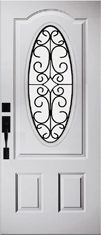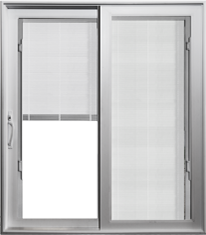We here at Northeast want to make your project and visit here the best it can be. You may encounter a term that needs more definition or clarity. Welcome to our Glossary of commonly used terms associated with windows, doors, or other products. If there is a term you do not see that we can help you understand, please Contact Us.
A | B | C | D | E | F | G | H | I | J | K | L | M | N | O | P | Q | R | S | T | U | V | W | X | Y | Z
Air Infiltration
Air that passes between a window sash and frame.
Argon Fill
A clear, odorless and non-toxic inert gas that reduces the thermal conductivity of the airspace between the glass layers.
A window unit that is hinged on the top, in which the bottom sash swings outward for ventilation.
Acoustics
The science of sound and sound control.
Adhesive
A substance capable of holding material together by surface attachment commonly referred to as glue.
Aesthetics
The appreciation of beauty or good taste.
Architectural Style
The characteristic form and detail of buildings from a particular historical period or school of architecture. Some examples include Colonial, Contemporary, Craftsman, Old World and Victorian styles.
Articulating Cap SIll Threshold
An automatically adjusting cap sill that springs up to meet the bottom edge of the door to close off leaks, drafts, insects or other elements from entering the interior of the home through the entryway.
Astragal
A special molding attached to one of a pair of doors that prevents them from swinging or sliding completely through the opening. Also to prevent air infiltration.
An angular, multi-panel window, usually made up of a large center fixed unit and two flanking units, projecting out from the wall of the home. The three window unit usually projects at 9, 15, 30, or 45 degree angles to the wall.
Bevel
To cut to an angle other than a right angle, such as the edge of a board or door.
Bottom Rail
The lower most horizontal member of a sash, door, blind or other panel assembly.
A composite of three or more window units joined together in a radial formation.
Cam Lock and Keeper
The mechanisms which pull the sash together when placed in the locked position.
Caming
Metal separator that holds individual pieces of decorative glass in place. Caming is typically brass with a variety of decorative finishes.
Casing
Molding of varying widths and thicknesses used to trim out interior or exterior door openings.
Condensation
The deposit of water vapor from the air on any cold surface whose temperature is below the dew point, such as a cold glass or frame that is exposed to humid air. Condensation also occurs when there is excessive humidity in the home.
Conduction
Energy transfer from one material to another by direct contact.
Condensation
Water vapor deposit from the air on any cold surface whose temperature is below the dew point, such as a window glass or frame that is exposed to cold outdoor air.
Conduction
The transfer of heat through matter, whether solid, liquid, or gas.
Constant Force Balance System
A modular design of pre-stressed flat stainless steel formed into a coil, providing a smoother, quieter operation of the window. The energy of the balance system remains constant through every point of travel when the window sashes are raised and lowered.
Convection
A transfer of heat through a liquid or gas when that medium hits against a solid surface.
Convex
Curving or bulging outward (the opposite of concave).
Desiccant
An extremely porous substance used to absorb moisture and sustain dryness (desiccation) from within a sealed air space of an insulating glass unit.
Design Pressure
The pressure, positive and/or negative, that develops during severe weather events and that can threaten
the physical integrity of a home’s integral structure.
Door Face
The wide flat surface of a door.
Door Frame
A complete door frame consists of one header and two jamb legs. A strip of wood called a “stop” keeps the door from swinging through the frame. Stops are available rabbetted (Built-in) or Stitched (applied separately with staples).
Door Height
The vertical measurement of the door ranging from 6 feet, 6 inches to 7 or 8 feet.
Door Jamb
The part of a door frame which surrounds and contacts the edges of the stiles and top rail of a door. Jambs may be classified as (1) “head” or “side” jambs and
(2) “plain” or “rabbeted”.
Door Skin
The front or face panel (usually two or more plies) of a flush door.
Double Hung Window
A window unit that has two operable sashes which move vertically in the frame.
Double-Strength Glass
Glass with an approximate thickness of 1/8”.
Entry Door
A door typically found in the front of a home or building.
Exterior Threshold
A threshold non-symmetrically beveled, (the more gradual and longer bevel facing the exterior) which, when secured to the exterior door frame sill and/or finished floor, prevents water from driving under the door.
Extruded Screen Frame
This frame is pressed through a die and is extruded for quality and strength.
Extrusion
A form produced by forcing vinyl through a die.
Fenestration
The placement or arrangement and sizes of the windows and exterior doors of a building.
Frame
The material in which window sashes or door panels are mounted.
Foam Injected
The hollows inside the vinyl master frame are injected with polyurethane foam.
Fusion-Welded
The process that uses extreme heat and joins vinyl window materials together into one piece.
Glass
An inorganic transparent material composed of silica (sand), sodium bicarbonate (soda), and calcium carbonate (lime) with small quantities of alumina, boric or magnesia oxides.
Glazing
The process of sealing a piece of glass into a window.
Glazing Bead
A plastic strip applied to the window sash around the perimeter of the glass.
Grids (Grills)
Decorative horizontal or vertical bars installed between the glass panes to create the appearance of the sash being divided into smaller lites of glass.
Head
The horizontal top portion of the main frame.
Heat Loss
The heat transmission rate multiplied by the area of the door.
Hinge Jamb
Side jamb in which the door hinges (butts) are applied.
A window unit that is hinged on the bottom in which the top of the sash swings inward.
Impact Resistance
Impact resistance is the ability to withstand high forces or shocks occurring over a short period of time.
Homeowners in areas prone to severe weather often consider impact resistance as a significant factor in their home improvement decision-making.
Infiltration
Heat loss due to cold air filtering through cracks or spaces around an exterior door.
Insulating Glass Unit (IGU)
Two or more panes of glass separated by a spacer with a hermetically sealed air space.
J-Channel
Integrated extension on the outside of a new construction window for installation applications.
Jamb
The vertical members at the sides of a window frame.
Keeper Rail
The horizontal portion of the sash where the lock keeper is attached.
Knob Latch Set
Door hardware for keeping a door closed and with a spring-operated latch bolt activated by a knob. Also known as a passage set.
Laminated Glass
A laminated triple layer, comprising a clear flexible polymer sandwiched between two panes of glass. It helps to defend the home by withstanding debris, projectiles, and positive and negative design pre
Lift Rail
Extruded on the horizontal rails of the top and bottom sashes, it is used for raising and lowering the sashes.
Lock Block
A concealed block of wood or particleboard glued inside a door. When installing a lockset, a hole is drilled through the door faces and the lock block. It provides support for the lockset.
Lock-Tilt
A window hardware mechanism that allows both the open/close/lock function of the window and the release to tilt the sash away from or out of the window for cleaning.
Low-E (Low Emissivity) Glass
Microscopic layers of silver and titanium dioxide, which dramatically increase thermal performance and restrict the passage of radiant heat.
Meeting Rail
The part of a double hung window where the two panels meet and create a weather barrier.
Mullion
A component used for connecting multiple units together.
Obscure Glass
Any textured glass (frosted, diffusion, pebble, etc.) used for privacy, light diffusion, or decorative effects.
Operator
Crank-operated device used for opening and closing casement and awning windows.
Oriel Window
Window that features the meeting rail off center of the frame, usually a 1/3, 2/3 ratio.
A stationary window that is non venting.
Polyvinylchloride (PVC)
An extruded or molded vinyl polymer material used in window fabrication and as a thermal barrier for aluminum windows.
R-Value
A measure of the resistance to thermal transfer or heat flow. A higher R-value window has a greater resistance to heat flow and a higher insulating value.
Rough Opening
The opening in a wall into which a window or door unit is to be installed.
Sash
An assembly of stiles and rails made into a frame for holding glass.
Sidelite
An assembly of stiles and rails, with or without a wood panel containing a single row of glass panels or lights. Installed on one or both sides of an exterior door frame, especially a front entrance door frame. Sidelights provides light, especially for an entry hall, as well as decorative appeal.
A window that opens and closes horizontally. It is offered in both two and three lite configurations.
Solar Heat Gain Coefficient (SHGC)
Measures how well a window blocks heat from sunlight. The SHGC is the fraction of the heat from the sun that enters through a window. SHGC is expressed as a number between 0 and 1. The lower a window’’s SHGC, the less solar heat it transmits.
Stiffener
Reinforcement made from extruded aluminum,
extruded composite, or roll-formed steel to strengthen vinyl windows and increase their security.
Stile
The upright or vertical framework pieces of a door.
Strike Jamb
Jamb opposite the hinge jamb. A jamb on which the lock or passage-set strike plate is installed.
Strike Plate
A metal piece mortised into or fastened to the face of a door frame side jamb to receive the latch or dead bolt when the door is closed.
Structural Sealant
Single component, self-leveling, premium-grade polyurethane sealant with an accelerated curing capacity used to seal gaps, joints and cracks.
Sweep
A rubber or vinyl strip applied to the bottom of a door to create an effective seal against the sill (threshold).
Swing
Describes a door system which opens either in (toward the home) or out (away from the home), when in operation.
Tempered Glass
Glass that is strengthened through the process of heating and cooling the surface rapidly. This process allows the glass to withstand greater than normal forces on its surface. When it breaks, it shatters into small pieces to reduce hazard. Tempered glass is standard on all Entry Doors and Sidelitess.
Thermal Break
The addition of a thermal insulating material between two thermally conductive materials.
Thermoplastic Spacer
Integrated spacer extruded and applied directly to the glass, creating a true chemical bond that adheres to the panes through expansion and contraction with minimal conduction of heat or cold.
Tilt Latch
A mechanism that when depressed allows the sash to tilt-in from the frame for easy cleaning.
Transom
A horizontal member separating a door from a window panel above the door, or separating one window above another.
A window that fits over the top of a door or other window.
Trim
Millwork, primarily mouldings and/or trim to finish-off (trim around) window and door openings, fireplaces, walls and other members.
U-Value
Thermal conductivity (or the U-Factor) is the property of a material that indicates its ability to conduct heat. The lower the U-value, the better the insulating value.
Vinyl
Polyvinyl chloride material, used for window frames and fabrication.
Visible Light Transmittance
A measure of the amount of visible light that passes through the glazing area of a window.
Weatherstripping
A strip of material used to seal the joint between the window sash and frame. Also used with our Entry Doors, the flexible material surrounding the door to protect your home from air infiltration.
Windload
Force exerted on a surface by the movement of air.



























